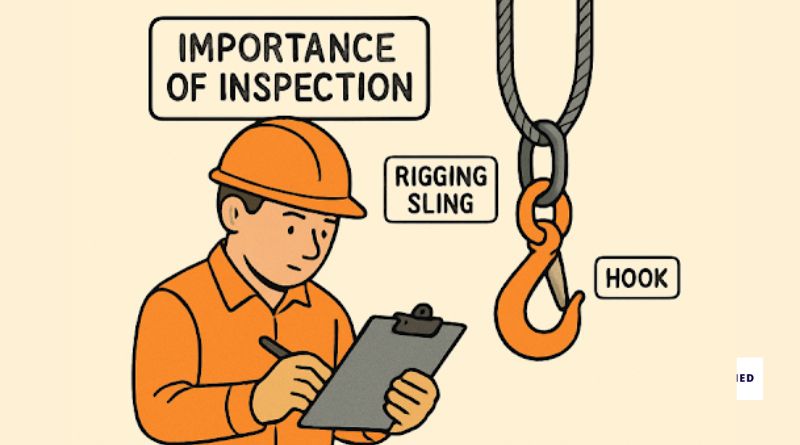Why Industrial Safety Hinges on Rigging
Industrial rigging is foundational in sectors like manufacturing, warehousing, and construction. This discipline encompasses the lifting, hoisting, and moving heavy equipment, materials, and structural components.
The integrity of these components is critical: a single failure can result in catastrophic accidents, property loss, or even fatalities. With such high stakes, organizations frequently turn to specialists for inspections and maintenance or seek reliable wire rope sling near me providers who emphasize safety and compliance. Inattention to rigging upkeep can lead to equipment breakdowns, costly downtime, and increased business liability risk.
Core Elements of a Rigging Inspection
- Visual Examination: Assess all rigging apparatus, including slings, fasteners, hooks, and lifting devices for visible signs of wear, corrosion, fraying, or deformation.
- Functional Testing: Where feasible, test gear under light load to observe its function and detect subtle performance issues.
- Identification Checks: Verify that equipment labels, load ratings, and certifications are readable and up-to-date.
- Assessment of Attachments: Inspect the connection points, shackles, and any hardware for loosening, cracking, or fatigue.
- Documentation: Maintain a complete record of inspection results, issues found, and actions taken to assist with regulatory compliance and continuous improvement.
According to industry standards, rigging gear should be inspected before each use and subjected to more thorough periodic examinations—usually at least annually, but ideally more frequently in harsh or high-volume environments. Keeping diligent records fulfills OSHA mandates and helps spot trends and recurring issues, underpinning a preventive maintenance approach.

Common Rigging Failures and Their Warning Signs
Typical Points of Failure
- Slings: Fraying, kinking, broken wires, or cuts in fabric slings
- Hooks: Bending, cracks, or worn-out safety latches
- Shackles: Thread damage, elongation, and surface defects
- Lifting Devices: Deformation, corrosion, or mechanical malfunction
Warning Signs Requiring Immediate Action
Visible issues (like broken wire strands or distorted shackles) and non-visible ones (such as internal corrosion or fatigue) can signal hazardous conditions. Regular visual and hands-on functional checks are essential for uncovering subtle defects before they pose a serious safety threat. Employing nondestructive testing methods for certain rigging gear can substantially enhance safety outcomes.
How Rigging Repairs Prevent Workplace Accidents
Timely repairs to damaged or worn rigging equipment are directly linked to significant hazard reduction on job sites. A consistent maintenance and repair schedule can lower the risk of uncontrolled drops or sudden equipment failures. According to OSHA’s workplace injury data, rigging failures result in thousands of preventable injuries annually, many of which are due to neglected inspections or delayed repairs.
Standards and Compliance: Meeting Regulatory Requirements
Strict occupational health regulations govern rigging inspection and repair. The Occupational Safety and Health Administration (OSHA) and organizations like the American Society of Mechanical Engineers (ASME) set the bar for frequency and thoroughness of rigging assessments.
- OSHA: Requires daily to periodic inspections depending on frequency of use and environmental exposure
- ASME: Issues detailed guidelines on the qualifications required for rigging inspectors and safe equipment operation
Maintaining regulatory compliance does more than prevent fines—it establishes accountability. It demonstrates a commitment to workplace safety. Emerging regulations are anticipated to incorporate technological advances, such as digital recordkeeping and remote inspection tools, that further streamline risk management.
The Role of Training and Certification
No rigging inspection or repair program is effective without well-trained, knowledgeable personnel. Operators and inspectors should possess more than just hands-on skills—they need an up-to-date understanding of equipment ratings, industry standards, and hazard recognition. Certification through accredited programs ensures workers meet the baseline requirements set by regulatory agencies.
Implementing a Proactive Inspection Regimen
Step-by-Step Guide
- Establish an inspection schedule tailored to equipment type and usage frequency.
- Develop or adopt checklists adapted from industry best practices and regulatory bodies.
- Train staff on visual and functional inspection techniques and documentation protocols.
- Utilize digital tools for streamlined recordkeeping and proactive maintenance alerts.
- Continuously review program outcomes and adjust as necessary to close gaps or address emerging risks.
While implementing this approach has upfront costs, the investment pays dividends by reducing emergency repairs, minimizing downtime, and lowering insurance and liability costs. The long-term benefits of preventing incidents and protecting the workforce outweigh the expenses.
Fostering a Culture of Safety Through Rigging Diligence
Rigging inspection and repair are not mere checkboxes but foundational practices that anchor workplace safety, productivity, and compliance. Regular, proactive maintenance protects lives, property, and reputations and sets an example for industry-wide diligence. Leaders should emphasize that rigorous inspection routines and immediate repairs are fundamental responsibilities, not occasional tasks.
Prioritizing these practices and promoting ongoing education fosters a culture where safety is second nature—driving continuous improvement and making industrial workplaces safer for everyone.

